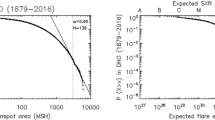Abstract
Allδ-sunspots from September 1986 to December 1992 in solar cycle 22 are used to investigate the characteristics ofδ-sunspots and the relationship betweenδ-sunspots and X-class X-ray flares. The main results of this statistical study are as follows.
-
(1)
The earlier discoveries on the formation and disintegration patterns ofδ-sunspots (Tang, 1983; Zirin and Liggett, 1987; Zirin, 1988) are confirmed. In a general sense, allδ-sunspots form from the penetration of two different dipoles. Delta-sunspots could be disintegrated byin situ flux cancellation. In addition, someδ-sunspots become separated by the sliding apart of opposite polarities.
-
(2)
A prominent characteristic ofδ-sunspots is the imbalanced flux between the two polarities. A sample of 58δ-sunspots observed by the Solar Magnetic Field Telescope at Huairou, in which there are one or more X-class flares, maintains an average flux ratio of 6.6 between the majority and minority polarities. Unlike the early results of Tang (1983), two-third of them show a dominant flux from the preceding spots.
-
(3)
The number ofδ-sunspots seems to be an index of solar activity. More than 95% of X-class X-ray flares take place in active regions ofδ-sunspots; while 23% ofδ-sunspots are generators of X-class X-ray flares. The productivity of X-class flares is closely correlated to the lifetime ofδ-sunspots in this manner:P xxf = −0.12 + 0.02T Emphasis>/2 δ .
Similar content being viewed by others
References
Hale, G. E. and Nicholson, S. H.: 1938,Magnetic Observations of Sunspots, Carnegie Institution of Washington, Washington, D.C.
Künzel, H.: 1960,Astron. Nachr. 285, 271.
Livi, S. H. B., Wang, J., and Martin, S. F.: 1985,Australian J. Phys. 38, 855.
Martin, S. F., Livi, S. H. B., and Wang, J.: 1985,Australian J. Phys. 38, 929.
Sheeley, N. T., Jr.: 1966,Astrophys. J. 144, 723.
Tang, F.: 1983,Solar Phys. 89, 43.
Wang, H.: 1992, in K. L. Harvey (ed.),Solar Cycle, ASP Conference Series 27, p. 97.
Wang, H., Tang, F., Zirin, H., and Ai, G.: 1991,Astrophys. J. 380, 282.
Wang, J. and Shi, Z.: 1993,Solar Phys. 143, 119.
Wang, J., Shi, Z., Martin, S. F., and Livi, S. H. B.: 1987,Vistas Astron. 31, 79.
Warwick, C.: 1966,Astrophys. J. 145, 215.
Xu, A-a, Yin, C-l., Zhang, H-q., and Wu, S. T.: 1991,Acta Astron. Sinica 32, 36.
Zirin, H.: 1988,Astrophysics of the Sun, Cambridge University Press, Cambridge.
Zirin, H.: 1993, in H. Zirin, G. Ai, and H. Wang (eds.),Solar Magnetic and Velocity Fields.
Zirin, H. and Liggett, M.: 1987,Solar Phys. 113, 263.
Zirin, H. and Marquette, W. H.: 1991,Solar Phys. 131, 149.
Zirin, H. and Wang, H.: 1990,Solar Phys. 125, 45.
Author information
Authors and Affiliations
Rights and permissions
About this article
Cite this article
Shi, Z., Wang, J. Delta-sunspots and X-class flares. Sol Phys 149, 105–118 (1994). https://doi.org/10.1007/BF00645181
Received:
Revised:
Issue Date:
DOI: https://doi.org/10.1007/BF00645181




